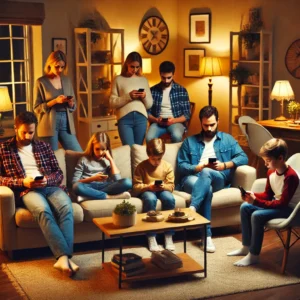The Digital Disconnect: Why Social Media is Replacing Real-Life Connections
The Digital Disconnect: How Social Media is Replacing Real-Life Relationships.

In the bustling tapestry of the 21st century, social media has woven itself into the fabric of our lives, becoming an integral part of our daily interactions. Once, our relationships were primarily nurtured through face-to-face encounters, shared experiences, and heartfelt conversations. However, the advent of social media platforms has dramatically altered this landscape, leading to a concerning trend; the erosion of genuine human connections.
Table of Contents:
- The Shift from In-Person to Online Interactions
- The Impact of Social Media on Relationships
- The Need for Balance
- Conclusion
The Shift from In-Person to Online Interactions –
 The 20th century was a time when friendships and family bonds were forged through shared experiences and physical proximity. People spent quality time together, engaging in activities that fostered a sense of camaraderie and belonging. However, the rise of social media in the 21st century has ushered in a new era of communication, one that is increasingly mediated by technology.Platforms like Facebook, Instagram, Twitter, and WhatsApp have become the primary avenues for social interaction, offering a convenient way to stay connected with friends, family, and acquaintances. While these platforms have undoubtedly made it easier to maintain relationships across vast distances, they have also led to a decline in in-person interactions.
The 20th century was a time when friendships and family bonds were forged through shared experiences and physical proximity. People spent quality time together, engaging in activities that fostered a sense of camaraderie and belonging. However, the rise of social media in the 21st century has ushered in a new era of communication, one that is increasingly mediated by technology.Platforms like Facebook, Instagram, Twitter, and WhatsApp have become the primary avenues for social interaction, offering a convenient way to stay connected with friends, family, and acquaintances. While these platforms have undoubtedly made it easier to maintain relationships across vast distances, they have also led to a decline in in-person interactions.
The Impact of Social Media on Relationships –
 The proliferation of social media has had a profound impact on the way we relate to one another. While it has made it easier to stay connected, it has also created a barrier between people. The constant stream of updates, likes, and comments can create a distorted perception of reality, leading to feelings of inadequacy and isolation.
The proliferation of social media has had a profound impact on the way we relate to one another. While it has made it easier to stay connected, it has also created a barrier between people. The constant stream of updates, likes, and comments can create a distorted perception of reality, leading to feelings of inadequacy and isolation.
Moreover, the superficial nature of many social media interactions can undermine the depth and authenticity of human connections. While it’s easy to share a quick message or post a photo, it takes effort to cultivate meaningful relationships. The focus on likes and followers can also lead to a superficial and performance-driven approach to social interaction.
The Need for Balance –
![]()
While social media can be a valuable tool for staying connected, it’s important to recognize its limitations. It’s essential to strike a balance between online and offline interactions. Spending too much time on social media can detract from real-life relationships and lead to feelings of isolation.
To foster meaningful connections, it’s crucial to prioritize in-person interactions, engage in activities that promote social bonding, and cultivate a sense of gratitude for the relationships in your life. By doing so, we can ensure that technology complements, rather than replaces, the richness and depth of human connection.
Conclusion

In today’s digital age, social media is both a blessing and a challenge. It provides a way to stay in touch with loved ones but risks overshadowing the face-to-face interactions that are essential to truly meaningful relationships. By acknowledging the digital disconnect, we can work towards a balanced approach that embraces the best of both worlds—ensuring that technology enhances, rather than replaces, our human connections.
A K Narayanan
www.motivedomain.com



